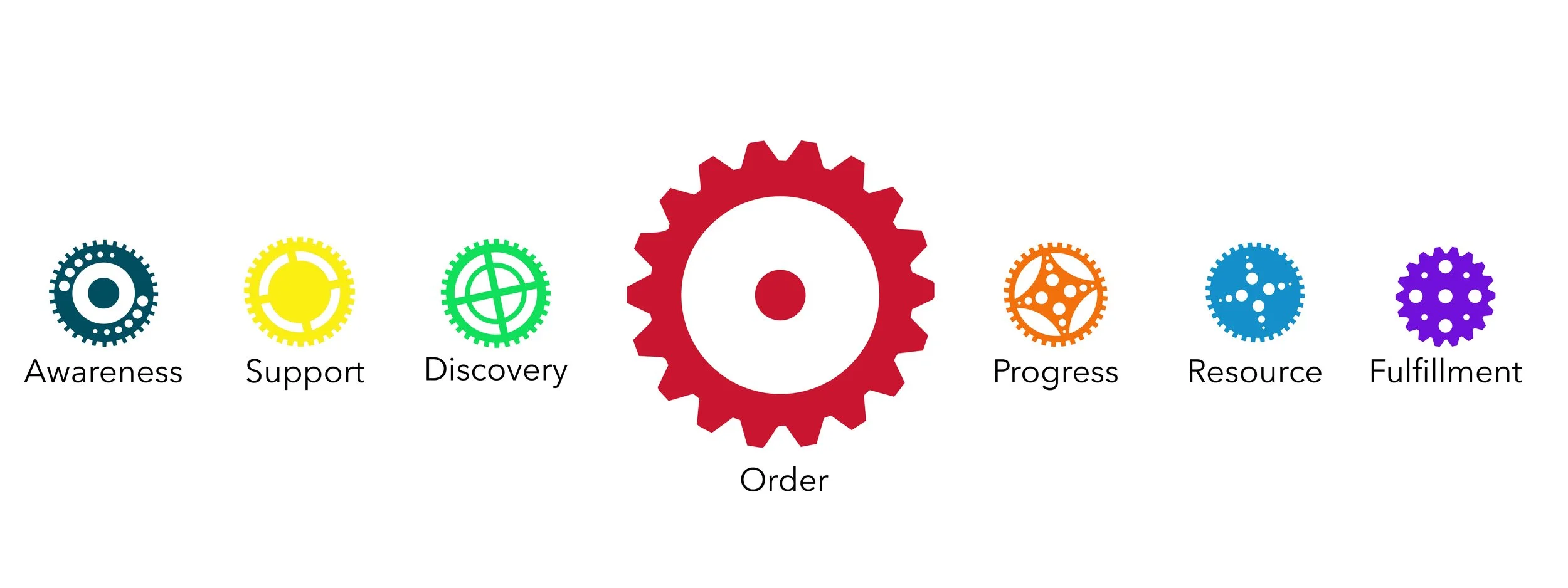the Identifier | Essential

design Profile
synergistic Design
You have a Synergistic Design.

Profile
syn·er·gis·tic
/sinərˈjistik/
Defining synergy
Synergy is the concept where the combined effect of multiple elements working together exceeds the sum of their individual effects. In a synergistic relationship, components—whether they be people, ideas, systems, or resources—interact in such a way that they enhance and amplify each other’s strengths, resulting in outcomes that would not be achievable by any single element working alone. This dynamic interplay fosters efficiency, creativity, and resilience, as each part complements the others, filling in gaps and reinforcing shared goals. Synergy transforms isolated efforts into cohesive, powerful forces by aligning resources and efforts toward a common purpose. In organizations, synergy can lead to increased productivity, innovation, and satisfaction, as individuals and teams work in harmony to create greater value than they could independently.
Clever + Driven + Systematic + Welcoming
LEARN MORE ABOUT MOTIVATIONAL DESIGN
Synergistic Design
Core Traits
READ ALONG | JUST LISTEN
Snapshot
You are characterized by your ability to bring people and systems together to create harmony and achieve shared goals. You have a natural talent for organization, collaboration, and seeing how all the pieces fit into a cohesive whole. Your focus on creating order and fostering connection enables you to build systems that are both effective and sustainable. Below is an extensive profile of your synergistic design, highlighting your core characteristics, strengths, potential pitfalls, and strategies to optimize your abilities for success in both personal and professional life.
Breakdown
click + expand
-
You have an innate skill for blending different perspectives, ideas, and talents into a unified whole. For you, integration isn’t just about collaboration for efficiency; it’s about finding alignment that creates functionality and beauty beyond individual components. You view diversity as an essential asset, believing that combining varied strengths elevates the entire team. Your approach results in solutions that are both comprehensive and harmonious.
-
Your perspective is inherently systemic, understanding how parts interrelate within the whole. You look beyond isolated facts, focusing on the interactions among system elements to create structures, processes, or environments where every part has a purpose and enhances overall synergy. This ability to perceive hidden connections allows you to foresee outcomes that others might miss. You build systems that not only work but are sustainable over time.
-
You are attuned to the interconnectedness of individuals, teams, and ideas. Recognizing how one part affects another is second nature, enabling you to create harmony by understanding the intersections of relationships, processes, and goals for long-term success. This skill enables you to detect potential issues early on, providing preventive solutions. Your insight into interdependence often makes you the grounding force within any group.
-
You are naturally inclined to ensure smooth, mutually beneficial interactions. You can sense when things are out of sync and instinctively restore balance, making you exceptional in conflict resolution, negotiation, and team-building. You prioritize understanding all perspectives, allowing you to mediate effectively. By creating spaces of mutual respect, you foster trust and cooperation among team members.
-
While focused on present harmony, you are also forward-thinking. True synergy, in your view, requires long-term planning and adaptability. You envision the evolving potential of relationships, projects, and systems, extending beyond immediate outcomes. By anticipating future trends, you can position projects to thrive in changing circumstances. Your strategies often inspire others to see beyond the present moment.
-
Leading by example, you inspire collaboration instead of dictating it. You encourage open communication, recognize everyone’s strengths, and guide groups toward shared goals. Your leadership blends authority with empathy and guidance with flexibility. You see each team member’s contributions as invaluable, fostering a sense of shared purpose. This inclusive approach builds loyalty and motivates others to give their best.
-
Your empathy extends to understanding the collective emotions of groups. With insight into collective needs and concerns, you foster a cohesive, supportive environment and navigate complex social dynamics with diplomacy and grace. Your understanding of emotional undercurrents helps you address unspoken needs. This ability makes you a confidant and a source of support for many.
-
You know that synergy requires flexibility, and you’re skilled at adjusting your strategies as circumstances change. For you, balance is not a static state but a continuous realignment of evolving elements. This adaptability allows you to remain calm amid unexpected changes, finding opportunities in shifts. Your approach inspires others to embrace change with an open mindset.
"In a world full of moving parts, your leadership creates balance—your work builds not just systems but legacies of connection and purpose."
Watch the Full video
Order
READ ALONG | JUST LISTEN
Synergistic designs are driven by the motivational drive of Order. Order is the drive that seeks to establish harmony, structure, and a well-functioning arrangement within any environment. It is motivated by the desire to bring clarity, consistency, and purpose to situations, ensuring that every part of a system works together effectively. Order operates by organizing elements in a way that allows them to interact seamlessly, creating an environment that minimizes chaos and fosters cohesion.
For individuals with a synergistic design, the Order drive leads them to see every group, project, or organization as an interconnected system where each part plays a unique role. At work in the synergistic design, Order enables these individuals to align people, processes, and resources in a way that maximizes harmony and balance. They are fulfilled by creating spaces where collaboration flows smoothly, and where each component supports and enhances the others, achieving a sense of unified purpose.
-
In a synergistic design, the Order drive shapes the way individuals approach any system or environment. They view every setting—whether a team, project, or organization—as an interconnected whole where each part has its unique role but ultimately contributes to a seamless flow. For them, Order provides the blueprint for creating functional, harmonious systems that bring out the best in every component.
-
Synergistic individuals, guided by Order, prioritize structure as the foundation for effective collaboration. They understand that for anything to function optimally, each element must have a defined place and purpose. This drive for structure and precision ensures that resources are organized, roles are clear, and processes are predictable. By building environments with careful attention to structure, they create a space where everyone can rely on stability, freeing individuals to contribute their best within a well-defined framework.
-
Order-driven synergists are motivated by precision and predictability because these qualities reinforce cohesion and flow. Predictability provides a sense of security, and precision ensures that each part of the system works without unnecessary friction. This preference helps them establish routines and standards that everyone can trust, allowing them to create a strong foundation on which synergy can thrive. Predictable processes allow individuals to focus on their contributions, knowing that their efforts will align with the greater whole.
-
The Order drive in synergistic designs places a high value on collaboration and connection. They believe that when people work together in a well-organized way, their combined efforts produce results far greater than what each could achieve alone. For them, synergy emerges from creating a culture where collaboration is supported by clear systems and open channels of communication. Order-driven synergists see themselves as facilitators, aligning resources and relationships to create a supportive environment where everyone’s strengths are fully utilized.
-
Those with a synergistic design are not content with simple order; they aim to create systems where each part enhances the other. To them, synergy is achieved when the whole system operates fluidly, with each component contributing to a unified purpose. Order allows them to build these systems with careful attention to how each element interrelates, making them skilled at designing processes that promote continuous flow and eliminate bottlenecks. Their fulfillment comes from watching these systems come to life, knowing that each part has a meaningful role in the success of the whole.
-
For synergistic designs, fulfillment lies in witnessing harmony—when a team, process, or environment is working together as one cohesive unit. This sense of harmony brings them deep satisfaction, as it aligns perfectly with their drive for Order. They are motivated by the peace and satisfaction that comes from knowing that every part of the system is doing its job, contributing to a balanced and effective whole. To them, a well-ordered, harmonious environment is the ultimate achievement, as it reflects the fulfillment of their core purpose.
-
The Order drive in synergistic designs also instills a commitment to long-term stability and sustainable growth. Synergistic individuals understand that stability is essential for maintaining harmony over time. They approach projects and systems with a focus on sustainability, ensuring that what they create will continue to function and grow as needs evolve. This long-term perspective means they’re often strategic thinkers who plan for the future, valuing practices that will support continuity and resilience within the systems they build.
-
In synergistic designs, the Order drive fosters a balance between independence and interdependence. They recognize that each part of the system, while unique, is most effective when working in tandem with others. Their design is about creating environments where individuals can excel in their roles while being part of a cohesive team. This balance allows each person to feel valued for their unique contributions while understanding how their role fits into the larger picture, reinforcing a sense of unity and shared purpose.
Synergistic Designs are about bringing people and processes together in a way that creates flow, cohesion, and a shared sense of purpose. The Order drive equips these individuals with the ability to see beyond isolated parts, envisioning a greater whole where everything works in concert. Through structure, precision, collaboration, and sustainability, they craft environments where synergy flourishes, creating systems that stand the test of time and bring fulfillment through unity and harmony.
"Your gift for creating harmony and structure transforms chaos into opportunity—never underestimate the power of your vision to bring people and systems together."
Watch the Full video
READ ALONG | JUST LISTEN
snapshot
You approach problem-solving holistically,
focusing on root causes to develop sustainable solutions that address immediate needs and support long-term goals. With a talent for fostering collaboration, you unite people and leverage their strengths, creating an inclusive environment where everyone feels valued. Your systemic mindset enables you to design resilient, adaptable systems, prepared to endure challenges and remain equitable. As a mediator, you resolve conflicts empathetically, building trust and cooperation within teams. You promote growth by empowering others and fostering both personal and collective development. Finally, you blend vision with execution, grounding big-picture ideas in actionable plans that lead to successful outcomes.
breakdown
click + expand
-
You tackle problems by considering all interacting factors, and focusing on root causes to create solutions that enhance the entire system. This holistic approach enables you to design strategies that are both effective and sustainable, ensuring that solutions address immediate needs while supporting long-term objectives. Your ability to see connections across various issues allows you to anticipate challenges others might miss. This perspective ensures that your solutions are robust and adaptable, supporting continued success.
-
You excel at uniting people and leveraging individual strengths to form a cohesive team. Acting as the “glue,” you facilitate dialogue, mediate conflicts, and build consensus, fostering a culture of respect and cooperation. Your ability to create this inclusive environment ensures that each person feels valued, leading to a more motivated and productive team. By nurturing collaboration, you help foster innovative ideas that often emerge from diverse perspectives.
-
With a systemic mindset, you design resilient structures that thrive through change. Whether in organizations, family routines, or community projects, you create adaptable, equitable systems that endure over time. This commitment to resilience means that the systems you build are prepared to withstand challenges while remaining effective and equitable. Your approach ensures that these structures support future growth while honoring the contributions of everyone involved.
-
Naturally balanced and aware of interdependence, you serve as a mediator, addressing tensions before they escalate. You focus on solutions that honor everyone’s needs, aiming for shared success rather than individual wins. By resolving conflicts with empathy and fairness, you help establish trust and cooperation within teams and communities. Your presence as a fair mediator fosters a sense of security and encourages open communication.
-
Recognizing each element’s role in the bigger picture, you create environments where collaboration drives personal and collective growth, empowering others to develop their potential. Your support and encouragement inspire people to reach beyond their current abilities, leading to stronger, more capable teams. This focus on growth ensures that both individuals and groups achieve lasting progress and fulfillment in their work.
-
You blend strategic vision with detail-oriented execution. Understanding that true synergy requires both big-picture thinking and practical steps, you ground your visions in clear, actionable plans. This balanced approach ensures that your ideas are not only inspiring but also achievable, helping you lead projects to successful outcomes. By bringing your vision to life with precision, you set a standard for excellence that others find motivating and inspiring.
READ ALONG | JUST LISTEN
snapshot
In prioritizing harmony, you may avoid conflicts, allowing issues to remain unresolved and potentially undermining the unity you seek. Your tendency to consider all nuances can lead to overcomplicating straightforward situations, resulting in excessive planning and hindering progress. Over-adaptability, though valuable, may sometimes lead you to neglect your own priorities, stretching yourself too thin. A strong respect for others' input can make unilateral decisions challenging, slowing progress when decisive action is needed. Finally, taking on too many responsibilities can lead to burnout, making boundary-setting and delegation essential for maintaining energy and achieving long-term goals.
breakdown
click + expand
-
In the pursuit of balance and unity, you may avoid necessary conflicts or difficult conversations. This tendency to prioritize peace can sometimes leave issues unresolved, allowing them to fester and potentially disrupt the harmony you strive to maintain. By sidestepping conflict, you may unintentionally create an environment where underlying issues inhibit genuine collaboration and growth. Acknowledging that constructive conflict can strengthen relationships may help you engage in challenging discussions with greater confidence. Embracing occasional discord as a pathway to deeper unity can enhance trust and authenticity in your relationships.
-
Your natural inclination to see interconnections might lead to overcomplicating situations that need a straightforward approach. This desire to consider every nuance can result in excessive planning or even analysis paralysis, hindering progress. Simplifying complex issues when needed could allow you to reach more efficient and effective solutions. Learning to focus on core priorities first may help you manage complex tasks without losing clarity. By distilling situations down to their essentials, you can direct your efforts toward impactful, timely decisions.
-
While your flexibility is a strength, it can sometimes mean losing sight of your own needs or priorities. In accommodating others, you may stretch yourself too thin or compromise your personal boundaries, affecting your well-being. This over-adaptability may lead you to prioritize others' goals over your own, ultimately reducing your overall effectiveness. Regularly assessing your own needs helps ensure that your adaptability remains balanced. Practicing self-advocacy can also reinforce boundaries, allowing you to support others without compromising yourself.
-
Your respect for others’ input can make it challenging to make unilateral decisions when necessary. Focusing too heavily on consensus can slow down progress in situations where quick, decisive action is required. In these moments, embracing assertiveness can help you drive momentum without sacrificing team cohesion. Recognizing when a decision is urgent allows you to act confidently while still respecting diverse perspectives. Developing a personal decision-making framework may also ease the burden of going forward independently when needed.
-
Driven to integrate and improve systems, you may take on excessive responsibilities. This sense of duty to ensure cohesion among all parts can lead to burnout if you don’t manage your energy and delegate effectively. Learning to set boundaries and trust others with certain tasks can help you sustain your energy for long-term goals. By identifying areas where others can contribute, you can foster a collaborative environment while preserving your own well-being. Allowing others to share responsibility strengthens the team’s resilience and amplifies your collective impact.
READ ALONG | JUST LISTEN
snapshot
To optimize your strengths as a synergistic individual, balance openness with intentional boundaries to avoid overextending yourself. Embrace constructive conflict as a tool for growth, using it to address issues while maintaining harmony. Simplify where possible by focusing on core priorities, ensuring that you make meaningful progress without getting overwhelmed. Set boundaries that protect your well-being, helping you stay engaged and productive in a sustainable way. Balance adaptability with a clear sense of non-negotiable values, which allows you to stay true to your vision while remaining flexible. Use your big-picture perspective to guide your decisions, aligning daily actions with long-term goals to stay motivated. Practice decisive leadership by knowing when to take action independently, which fosters trust and momentum within your team. Finally, nurture a network of diverse relationships to provide support, fresh ideas, and collaborative growth, enriching both your personal and professional life.
breakdown
click + expand
-
Recognize that not all conflict is detrimental to harmony. By embracing constructive conflict, you can address underlying issues and strengthen relationships and systems. Learning to differentiate between harmful discord and necessary tension can help you facilitate growth without compromising your values. When you approach conflicts as opportunities for insight rather than threats, you create room for authentic dialogue. This openness allows everyone involved to share perspectives that could lead to stronger, more resilient connections. Working through disagreements with transparency can clarify shared goals and lead to a deeper understanding among team members. A healthy approach to conflict can turn potentially divisive issues into areas for unity and collaboration.
-
Practice the art of simplicity. While your holistic thinking is an asset, focusing on the most impactful elements can streamline your efforts and prevent over-complication. Setting clear priorities helps you maintain focus and achieve results without becoming overwhelmed by every detail. Embracing simplicity doesn’t mean ignoring nuances but rather identifying the core issues that matter most. By narrowing your focus, you reduce stress and increase productivity, freeing up energy to tackle tasks with greater impact. This approach also helps others follow your lead, as they’ll have a clear understanding of what’s important. Simplifying complex challenges allows you to make thoughtful progress without getting bogged down in unnecessary intricacies.
-
Developing and enforcing personal boundaries is crucial for maintaining your well-being. By learning to say no and delegate responsibilities, you can ensure that you remain effective in your role as an integrator without overextending yourself. Healthy boundaries prevent burnout and preserve your capacity to stay engaged with what truly matters. When you prioritize your own needs alongside those of others, you create a sustainable balance that benefits everyone. Setting limits on your time and energy lets you focus on projects that align with your values and skills. Clear boundaries also signal respect for your own and others’ roles, establishing a foundation for cooperative, respectful relationships.
-
While flexibility is a hallmark of your design, learning when to be firm can enhance your effectiveness. Setting non-negotiable values or standards within your systems can provide the stability needed to support long-term harmony. A balanced approach allows you to adapt when necessary while standing firm on core principles. When you’re clear about the values you won’t compromise on, others know where you stand, which strengthens trust and respect. Balancing adaptability with firmness also means you’re open to new perspectives without losing sight of your goals. This approach gives you the flexibility to evolve in response to change while remaining true to your vision.
-
Use your ability to see the big picture as a guidepost. When faced with challenges, returning to your overarching vision can help you navigate uncertainty and maintain direction, ensuring that your efforts contribute to the desired outcome. A strong vision keeps you anchored in what’s most important, allowing you to persevere even in challenging situations. By aligning your daily actions with long-term objectives, you create a sense of purpose and focus that motivates others as well. Your vision can serve as a source of inspiration, reminding you and your team why you’re working toward a common goal. Revisiting your vision periodically helps you stay connected to your purpose and adapt your approach as needed.
-
While your collaborative nature is a strength, there are times when quick, decisive action is required. Developing the confidence to make decisions independently, when appropriate, will enhance your ability to lead effectively and keep systems moving forward. Decisiveness in key moments shows others that you can be relied upon to provide direction when needed. By trusting your judgment and assessing situations clearly, you build credibility as a leader who knows when to consult and when to act. Embracing decisiveness doesn’t mean abandoning collaboration but rather balancing it with timely action. Leading with decisiveness helps create a steady rhythm for your team, establishing consistency and instilling confidence.
-
You thrive in environments where you can connect with others. By building a network of diverse relationships, you can tap into a wide range of perspectives and resources that support your integrative approach to problem-solving and growth. Cultivating meaningful connections enriches your experience and brings new ideas that enhance your work. A well-rounded network also provides access to individuals who can challenge and inspire you, fostering continual personal and professional growth. Through ongoing interactions, you create mutually supportive bonds that strengthen over time. Your network serves as a valuable source of encouragement, insight, and collaboration, helping you achieve your goals while empowering others to reach theirs.
"Embrace your vision for harmony—it takes courage to bring order to the world in a way that benefits all."
Synergistic Design
ideal roles+environments
For individuals with a synergistic design, roles that emphasize collaboration, harmony, and strategic thinking provide an ideal environment to thrive. In team and project leadership, you excel at uniting diverse perspectives and creating an inclusive and motivated environment. Organizational development roles, such as HR or change management, leverage your ability to design systems that promote adaptability, collaboration, and sustainable success. Your empathic nature and dedication to balance make you well-suited for mediation and conflict resolution, where you foster trust and positive relationships. Community-building roles allow you to connect diverse groups, inspire cooperation, and cultivate a strong sense of shared purpose. In strategic planning, your foresight and capacity for navigating complex systems enable you to align all parts of an organization for long-term growth and resilience, ensuring a proactive approach to future challenges.
Ideal Roles
READ ALONG | JUST LISTEN
snapshot
You excel in Team and Project Leadership by uniting diverse teams toward shared goals, creating an inclusive and motivated work environment. In Organizational Development, your systemic approach is key to designing adaptive structures that promote efficiency and harmony, fostering a sustainable and positive culture. Your empathic approach makes you a strong candidate for Mediation and Conflict Resolution, where your balanced perspective enables constructive, lasting solutions. Community-building roles also suit you well, as your consensus-building skills inspire cooperation and foster a shared sense of purpose. Finally, your strategic outlook and foresight are ideal for Strategic Planning, where you ensure long-term success through adaptability and alignment across all organizational levels.
breakdown
click + expand
-
You are a natural fit for roles that involve guiding diverse teams toward shared goals. With strengths in project management, team leadership, and cross-functional integration, you excel in uniting various aspects of a project or organization. Your ability to harmonize differing perspectives allows you to create an inclusive atmosphere where all team members feel valued and motivated. By fostering a supportive environment, you empower each individual to contribute their best toward collective success.
-
Your systemic mindset is well-suited for roles in organizational development, change management, or HR, where you can design structures that foster harmony, collaboration, and efficiency across the workplace. In these roles, your knack for aligning team dynamics with organizational goals helps create an adaptable and positive culture. You prioritize building systems that not only serve immediate needs but also ensure sustainable success.
-
Your empathic nature and commitment to balance make you ideal for mediation, negotiation, and conflict resolution roles, where your skills can create win-win outcomes and support positive relationships. By addressing conflicts constructively, you enable long-term trust and cooperation between parties. Your unbiased perspective helps create solutions that honor everyone’s needs, promoting lasting harmony.
-
You flourish in community-building positions in nonprofits, education, or local government, where your talent for consensus-building and system development enhances collective well-being. Your ability to connect with diverse groups and inspire cooperation fosters a strong sense of community and shared purpose. You bring people together around common goals, strengthening relationships and cultivating a supportive, cohesive environment.
-
In strategic planning roles, you can use your big-picture perspective and ability to navigate complexities, ensuring that all parts of an organization or initiative work in alignment toward long-term success. Your foresight allows you to anticipate future needs and adapt strategies to evolving circumstances, driving sustainable growth. By integrating clear goals with adaptable methods, you help organizations remain resilient and proactive in the face of change.
Ideal Environments
READ ALONG | JUST LISTEN
snapshot
For you, a synergistic design, the ideal environment is one that fosters harmony, collaboration, and a sense of shared purpose, where you can draw together different elements into a cohesive, functional whole. Emotionally, you thrive in settings that allow you to connect deeply with others, align team strengths, and support a balanced atmosphere that encourages growth for everyone involved. Socially, you flourish when surrounded by open-minded, communicative individuals who value your capacity to see connections and nurture a collective vision.
breakdown
click + expand
-
Description: In a collaborative and inclusive environment, teamwork is paramount, with all voices encouraged and valued. The focus is on shared goals, respect for diversity, and appreciation of each individual’s unique perspective. This culture not only nurtures trust but also creates a cohesive team dynamic, where everyone feels they play an integral role in achieving success together.
Emotional Impact: Engaging in a team where contributions are recognized and individual strengths are celebrated brings you fulfillment and pride. This nurturing atmosphere empowers you to contribute authentically, feeling valued for your unique perspective.
Social Dynamic: You naturally gravitate toward environments where everyone feels essential to the group’s success, strengthening your motivation to contribute positively. This inclusive culture allows you to build bridges, fostering a strong sense of belonging and teamwork.
-
Description: Environments that embrace diverse perspectives enable individuals to see the bigger picture and find creative solutions by drawing on varied experiences and backgrounds. This setting encourages curiosity and innovation, as everyone is invited to share their unique viewpoints and work towards a more comprehensive understanding of challenges and opportunities.
Emotional Impact: When diverse viewpoints are encouraged, you feel validated in your role as a connector and inspired to approach challenges holistically. This inclusivity boosts your enthusiasm and allows you to engage fully with complex problems.
Social Dynamic: In a culture that values different perspectives, you can connect meaningfully with others and facilitate a shared understanding. This respect for diversity strengthens trust and teamwork, fostering a sense of unity among colleagues.
-
Description: A culture focused on shared goals and vision unites team members under a common purpose. Here, individual achievements are celebrated within the context of the group’s success, making everyone feel invested in the journey toward collective accomplishments. This shared mission creates alignment and strengthens motivation among team members.
Emotional Impact: Working towards shared goals aligns your sense of accomplishment with group success, creating a deeply rewarding experience. Knowing your efforts contribute to a common purpose energizes you to give your best.
Social Dynamic: A united focus on common objectives builds cohesion among team members, encouraging genuine support. This alignment fosters strong relationships and a resilient network where everyone is committed to each other’s success.
-
Description: Open communication fosters a transparent, honest environment where information flows freely, and trust is built. In this setting, feedback is encouraged, and ideas are shared without fear of judgment. Team members feel respected and valued, knowing that transparency is a priority, and everyone can voice concerns or suggestions with confidence.
Emotional Impact: Transparency provides you with the trust and security needed to thrive. In an environment where communication flows openly, you feel valued and confident in the team’s unity, allowing you to engage fully.
Social Dynamic: Clear, open communication strengthens bonds among team members, making it easier to express thoughts and concerns. This honesty builds mutual understanding, fostering a cohesive and positive team dynamic.
-
Description: Flexibility with structure combines the stability of organized systems with the freedom to adapt as needed. This approach empowers individuals to explore creative solutions while maintaining a sense of order and progress. It’s an environment where people feel supported in finding their best ways of contributing, without being restricted by rigid processes.
Emotional Impact: Flexibility allows you to adapt without feeling constrained, providing a sense of creative freedom. This freedom to navigate challenges as they arise fosters empowerment and engagement.
Social Dynamic: Working in a flexible, adaptable team nurtures a positive, collaborative atmosphere where everyone feels valued for their unique contributions. This adaptability enhances team harmony and encourages each member to bring their best.
-
Description: In environments that value emotional intelligence and empathy, team members feel understood and supported on a personal level. Kindness and respect are the foundation, allowing individuals to connect deeply and work collaboratively. This emphasis on empathy creates a culture of support, where well-being and strong relationships are prioritized, enabling everyone to bring their best to the team.
Emotional Impact: Knowing empathy is valued provides a sense of comfort and acceptance, inspiring you to bring your best self to work. This emphasis on emotional intelligence enhances your motivation to connect deeply with others.
Social Dynamic: A focus on empathy helps you form meaningful connections with colleagues, creating a close-knit, supportive team. This shared commitment to well-being strengthens bonds, fostering a collaborative environment where everyone cares for each other’s success.
-
Description: Environments that prioritize constructive conflict resolution and open dialogue create a safe space for addressing differences productively. Rather than avoiding conflicts, team members are encouraged to approach them respectfully, ensuring everyone’s concerns are acknowledged and understood. This approach strengthens relationships, as trust and respect are cultivated through open and fair resolutions.
Emotional Impact: In settings that encourage healthy conflict resolution, you feel empowered and valued, knowing your voice will be heard. This constructive approach fosters security and belonging, strengthening your commitment to the team.
Social Dynamic: A focus on constructive dialogue supports consensus-building without disrupting team dynamics. This approach to conflict fosters trust, maintaining strong relationships and a cooperative, resilient culture.
-
Description: Roles that encourage big-picture thinking allow individuals to connect daily tasks to larger goals and long-term vision. This perspective supports strategic planning and systems-building, as team members can see how their contributions impact the organization’s broader objectives. Big-picture thinking fuels motivation and a sense of purpose, knowing one’s efforts drive forward meaningful progress.
Emotional Impact: Opportunities to focus on the big picture allow you to see the broader impact of your work, making daily tasks more meaningful. This perspective provides a deep sense of purpose and fulfillment, as your contributions align with larger goals.
Social Dynamic: A team that values long-term vision fosters a sense of shared ambition, where everyone feels motivated to work toward common future objectives. This alignment with the team’s vision energizes the group and enhances collaboration.
-
Description: A culture that promotes both personal and collective growth values development as a shared journey. Everyone is motivated to pursue their potential, with resources and support available for skill-building and advancement. This emphasis on growth fosters mutual encouragement and a positive atmosphere where each person’s progress contributes to the team’s overall success.
Emotional Impact: An emphasis on growth makes you feel validated and inspired, reinforcing your drive to improve yourself and help others. This commitment to development enriches your experience, creating a supportive and rewarding environment.
Social Dynamic: Working with others who prioritize growth fosters a network of mutual encouragement and progress. This shared focus on development strengthens relationships, creating a culture of support and motivation.
-
Description: Environments that prioritize facilitation and team-building focus on creating bonds and a sense of unity within the team. This setting emphasizes the importance of collaboration, empathy, and shared experiences. Individuals are encouraged to connect meaningfully, building relationships that contribute to a stronger, more cohesive team.
Emotional Impact: Roles that allow you to bring people together give you a sense of fulfillment and pride. Being able to foster a supportive, harmonious environment enhances your commitment to the team’s success.
Social Dynamic: Facilitating team unity lets you create meaningful relationships, enriching the social fabric of the group. This connection-building fosters a sense of community, where collaboration and empathy thrive within the team.
As a synergistic individual, you thrive in environments that foster collaboration, openness, and a shared sense of purpose. Emotionally, you are most fulfilled in settings where teamwork and inclusion are prioritized, allowing you to connect deeply with others and support the group’s success. Socially, you excel in open, transparent cultures that value empathy, constructive dialogue, and flexibility. When you’re able to engage in big-picture thinking, facilitate harmony, and guide a team toward shared goals, you’re empowered to bring out your best qualities, contributing meaningfully to the collective well-being and unity of your group.
"Be brave in your desire for alignment and unity. Your ability to see how things work together inspires a shared purpose."
Watch full Video

READ ALONG | JUST LISTEN
You view the world through a lens of structure, balance, and interconnectedness. To you, everything has its place and purpose, and your mind is constantly mapping out how different parts fit together to create a cohesive whole. Your perspective is one of synergy; you naturally see how elements can be arranged and coordinated to work more effectively. This ability to understand and organize complex systems gives you a unique sense of clarity and purpose as you bring order to what may seem chaotic to others.
-
In your workplace, multiple departments are working on a large, complex project, but communication and workflow are disjointed, causing delays and confusion. While others focus only on their specific tasks, you naturally see how the departments’ efforts can be synchronized. You step in to create a clear project timeline, establish regular check-ins, and set up systems that ensure everyone knows their role and how it fits into the bigger picture. Your ability to map out the interconnections between different teams brings structure to the chaos, ensuring that the project moves forward efficiently with all parts working in harmony.
-
At work, you notice that the current team structure is leading to duplicated efforts and bottlenecks in productivity. Rather than simply pushing harder for results, you take a step back to analyze how the team’s strengths can be better utilized. You reorganize responsibilities, ensuring that each person is in the role where they can contribute most effectively. You also set up a system for clearer communication and task delegation, ensuring that every team member’s efforts are aligned with the overall goals. Your sense of balance and interconnectedness creates a more fluid, efficient team, increasing productivity and satisfaction among the staff.
-
In your relationships, you strive to create balance and harmony within your household. You naturally take on the role of organizing the household routines—ensuring that chores are divided fairly, schedules are coordinated, and every family member's needs are considered. By setting up a balanced system for meal planning, cleaning, and shared responsibilities, you create a sense of order that allows everyone to thrive. Your partner appreciates how smoothly things run, as your structured approach brings calm and clarity to the household, leaving more time for meaningful connection.
-
In your neighborhood, a group of residents decides to start a community garden, but the initial planning is chaotic, with no clear idea of how to allocate space, resources, or labor. While others focus on individual tasks, you step in to create a design for the garden that balances aesthetic appeal with functionality. You map out how the garden beds, walkways, and irrigation system should be arranged, ensuring that each element supports the others. By organizing the garden in a way that maximizes space and resources, you help create a thriving, interconnected ecosystem that the community can enjoy for years to come.
READ ALONG | JUST LISTEN
You prefer environments that emphasize structure, functionality, and harmony. Your standards are rooted in creating systems where tasks and individuals collaborate seamlessly, fostering synergy in all aspects. You value processes that are carefully planned, predictable, and executed with smooth flow, ensuring everything operates efficiently. Understanding your values means recognizing that your fulfillment comes from watching things work in perfect sync—whether it’s within a team, a project, or a personal pursuit. The beauty of a well-ordered environment, along with the peace it brings, is at the heart of your motivation.
structured + functioning + harmony + collaboration + synergy
-
You prefer environments that are thoughtfully organized and structured to ensure functionality. You value systems that enable tasks and people to work together seamlessly, creating a sense of order and purpose.
Example: When managing a project, you might design a clear workflow with defined roles and responsibilities, ensuring every team member knows how their work contributes to the bigger picture.
-
You value harmony in group dynamics and processes, preferring situations where individuals cooperate effectively toward shared goals. You believe that synergy comes from aligning strengths and minimizing conflict.
Example: In a team setting, you might mediate differing opinions to help the group find common ground, ensuring everyone feels heard and progress remains on track.
-
You prefer processes that are well-planned and predictable, valuing the efficiency and peace of mind that comes with smooth execution. Unexpected disruptions or inefficiencies can feel particularly frustrating to you.
Example: When organizing an event, you might create a detailed timeline and contingency plan to ensure everything runs smoothly, even if challenges arise.
-
You value creating systems where every component plays its role in achieving a cohesive outcome. You prefer designing processes that balance complexity with simplicity, ensuring functionality without unnecessary complications.
Example: When developing a strategy, you might map out interconnected steps, ensuring all parts of the plan support one another and contribute to the overall success.
-
You prefer environments that facilitate a natural, efficient flow of tasks and information. You value processes that reduce friction and enhance productivity, enabling everyone involved to work with ease and focus.
Example: At work, you might streamline communication by implementing tools or systems that help team members stay aligned and informed without unnecessary back-and-forth.
-
You value maintaining order while allowing flexibility for necessary adjustments. You prefer systems that are stable yet adaptable, capable of evolving in response to new challenges or opportunities.
Example: In a long-term project, you might establish a strong foundational plan while leaving room to adjust details as circumstances change, ensuring both structure and adaptability.
-
You value environments where tasks and roles are coordinated efficiently, minimizing redundancies and maximizing output. You prefer creating processes that ensure all efforts contribute directly to the desired outcome.
Example: When leading a group, you might assign tasks based on each person’s strengths, ensuring that resources are used effectively and everyone’s contributions align with the project’s goals.
-
You prefer spaces and systems that evoke a sense of calm and peace through their orderliness. You value the tranquility that comes from a well-organized environment, where everything has its place and purpose.
Example: At home, you might arrange your living space with intentionality, ensuring it feels comfortable and harmonious, promoting focus and relaxation.
-
You value the beauty of synchronization, preferring situations where tasks and individuals work together in a unified way. Watching these elements align and function cohesively brings you a deep sense of satisfaction.
Example: During a group project, you might guide efforts to ensure each member’s work connects seamlessly, creating a final product that reflects collective excellence.
-
You prefer achieving fulfillment by bringing order to chaos and purpose to actions. You value the sense of accomplishment that comes from creating harmony and alignment in your endeavors.
Example: When faced with a disorganized process, you might take the lead in reorganizing it, clarifying objectives, and aligning resources to ensure everything runs efficiently and effectively.
"Your ability to see how everything fits together is a rare talent—trust in your vision to create systems that inspire collaboration and achieve greatness."
Watch full video

READ ALONG | JUST LISTEN
Your pace is steady, methodical, and intentional. You approach tasks with a desire to establish rhythm and consistency, ensuring that each action fits seamlessly into a larger plan. You’re not one to rush; you prefer to take the time needed to arrange all elements properly so that they work together efficiently. Your rest comes from moments when everything is in its place, and the systems you’ve set up are running smoothly. This sense of harmony allows you to relax, knowing that things are functioning as they should.
In each of these examples, the dynamic pace is a tool they use intentionally for specific periods, while the slower, steady pace provides a grounding rhythm that sustains their fulfillment. This balance enables them to pursue goals and create harmony in various areas of life, all while staying aligned with their intrinsic need for structure and consistency.
click + expand
-
Dynamic Pace: Occasionally, when deadlines approach or unexpected issues arise, they might move into a focused, dynamic pace, prioritizing key tasks and coordinating closely with others to ensure the project stays on track. This heightened energy is intentional and aimed at reinforcing the system’s success.
Steady, Slower Pace: Once the project is in a stable phase, they return to a slower, methodical pace, focusing on refining details, reviewing progress, and ensuring all components align smoothly. This steady rhythm allows them to keep the project running efficiently without the need for constant adjustments.
-
Dynamic Pace: During times like seasonal cleaning or preparing for guests, they may take on a faster, dynamic pace, working quickly to reorganize, deep clean, or make needed changes to the household setup. This burst of activity is energizing and aligns with their love for creating a harmonious environment.
Steady, Slower Pace: On regular days, they maintain a slower, steady pace, following established routines like daily tidying, meal planning, or organizing spaces. This steady rhythm ensures a sense of calm and order, allowing them to enjoy their environment without feeling rushed.
-
Dynamic Pace: For special occasions, like hosting a party or celebrating milestones, they embrace a more dynamic pace, arranging details, coordinating with others, and preparing everything to make the event memorable. This intentional increase in pace energizes them, as it contributes to meaningful, well-organized social experiences.
Steady, Slower Pace: In day-to-day relationships, they prefer a slower, steady rhythm, such as weekly family dinners or regular check-ins with friends. These slower, consistent interactions foster deep, harmonious connections, allowing relationships to grow naturally over time.
-
Dynamic Pace: When they have a specific wellness goal—like preparing for a fitness milestone or engaging in a focused self-care challenge—they adopt a dynamic, disciplined pace. This includes more intense workouts, focused meal plans, or additional self-care activities that provide a refreshing boost to their routine.
Steady, Slower Pace: Outside of specific goals, they maintain a slower, steady pace, following a balanced daily wellness routine. Activities like morning meditation, light exercise, or journaling provide ongoing growth and relaxation without feeling hurried, helping them sustain a harmonious state of well-being.
-
Dynamic Pace: During times of significant financial planning—such as budgeting for a big purchase, managing investments, or preparing for tax season—they may adopt a more dynamic, focused pace. This could involve researching options, setting up new accounts, or making timely decisions to ensure financial security. This focused energy is intentional, aimed at maintaining long-term stability.
Steady, Slower Pace: In their regular financial routines, they prefer a slower, methodical approach, checking accounts periodically, saving consistently, and reviewing expenses. This steady rhythm allows them to manage their resources thoughtfully, creating a sense of security and peace in their financial life.
-
Dynamic Pace: When organizing or participating in a community event—such as a fundraiser, workshop, or special gathering—they may step into a dynamic pace, coordinating details, setting up schedules, and collaborating with others to ensure everything runs smoothly. This heightened involvement brings fulfillment through active contribution to the community.
Steady, Slower Pace: On a regular basis, they maintain a slower, consistent level of engagement, such as attending monthly meetings or offering support to others in a structured way. This steady pace allows them to be a reliable presence, helping them stay connected and contribute meaningfully without feeling overextended.
"Your vision for creating order is rare; trust in your gift to bring structure and harmony wherever you go."
WATCH FULL VIDEO

READ ALONG | JUST LISTEN
Your path to success involves creating and refining systems that bring order and unity. You excel at identifying how different components can work together to achieve a goal and at designing processes that maximize efficiency and productivity. Your process involves careful planning, coordination, and ongoing assessment to ensure everything remains aligned. You succeed when you transform chaos into a well-oiled machine, creating structures that not only address current needs but are adaptable for future growth.
Your path to success is built on your ability to connect, collaborate, and integrate different elements, whether they are people, ideas, or systems. You thrive in environments that require teamwork and cohesion, where your strength in bringing individuals and components together shines. Success, for you, is not about individual achievement but about how well you can foster harmony and ensure that everyone contributes to a shared goal. You are adept at recognizing the value each person or element brings and can create synergy that makes the collective stronger than its parts. Your focus on building bridges between people and processes is key to your success.
Rather than working in isolation, you succeed by facilitating cooperation and ensuring that everything is aligned toward a common purpose. You prioritize open communication, ensuring that all voices are heard and that everyone is on the same page. Success is defined by how effectively you can create systems where collaboration leads to greater outcomes than what individuals could achieve alone. You measure success by the harmony and cohesiveness you bring to your projects, ensuring that the results are not just effective but sustainable and beneficial to all involved. Your unique ability to unify and coordinate makes your path to success centered on collective achievement and lasting impact.
Natural Plan and Process of a Synergistic Design
As someone with a Synergistic design, your path to success revolves around collaboration, connection, and creating harmony among different elements. You excel at bringing together people, ideas, and systems, finding ways to maximize the collective potential of all parts. Your strength lies in your ability to see how things relate and how to integrate them into a cohesive whole, allowing for greater efficiency and impact. Your approach is driven by the belief that the sum is greater than its individual parts, and you thrive in environments where teamwork and integration are essential.
-
Your natural plan involves integrating diverse elements into a cohesive strategy. You prioritize ensuring that every part of the project or team is aligned and working toward a common goal. You focus on creating plans that are inclusive, taking into account the strengths and contributions of each individual or component.
Example: When managing a cross-functional project, you ensure that each department’s input is valued and seamlessly integrated into the overall strategy, creating a plan where everyone’s expertise contributes to the project’s success.
-
Once your plan is set, you focus on coordinating the efforts of everyone involved. You excel at facilitating communication and collaboration, ensuring that all parts of the project are moving in sync. Rather than micromanaging, you trust in the collective effort and focus on maintaining harmony and balance.
Example: While leading a product launch, you act as the bridge between marketing, design, and development teams, ensuring that everyone’s work is aligned and that any miscommunications are quickly addressed to keep the launch on track.
-
Your perseverance comes from your belief in the power of collaboration and the collective effort. Even when challenges arise, you trust in the team’s ability to work through them together. You maintain consistency by fostering open communication and ensuring everyone stays focused on the shared goal.
Example: During a project delay, you bring the team together to brainstorm solutions, leveraging the diverse perspectives to overcome obstacles and move forward as a unified group.
-
When problems arise, you approach them by leveraging the strengths of the group. Rather than trying to solve everything yourself, you rely on the collective wisdom and insights of your team to find the best solution. This approach allows for more creative and comprehensive problem-solving.
Example: When faced with a client’s changing demands, you gather the team to reassess the project’s direction, using the collective expertise to pivot and deliver a solution that meets the client’s needs without compromising the team’s workflow.
How You Define Success
Success, for a Synergistic design, is about achieving collective success and creating an environment where collaboration leads to greater results than individual efforts could. You define success by your ability to bring people and ideas together to create something greater.
-
You define success by achieving measurable outcomes that are the result of collaborative efforts. For you, success means seeing the collective contributions of the team come together to produce something impactful and greater than the sum of its parts.
Example: Leading a cross-departmental initiative that results in significant improvements in customer satisfaction and sales reflects the success of teamwork and integration.
-
Success, for you, involves creating a sense of harmony and balance in the workplace. You take pride in establishing systems and processes where all team members can work together efficiently and without conflict, ensuring that everyone is aligned toward the same goals.
Example: You implement a collaborative project management system that improves communication and streamlines workflows, ensuring that all departments stay on the same page throughout the project.
-
You build success by being a reliable facilitator who others trust to bridge gaps between people and departments. You’re seen as someone who can be relied upon to ensure that projects run smoothly by fostering cooperation and minimizing friction.
Example: Your reputation as a team player makes you the go-to person for managing complex projects that require collaboration between various teams, as people trust you to keep everything running smoothly.
-
For you, success is about creating sustainable systems of collaboration that can continue to function and produce results even after the project or initiative is completed. You aim to leave behind a legacy of strong teamwork and effective collaboration.
Example: By developing a mentorship program within the organization, you help foster long-term collaboration and professional growth, ensuring that teamwork and mutual support continue to thrive.
How You Go About Being Successful
You go about achieving success by facilitating collaboration, fostering communication, and integrating diverse perspectives. You believe that when people work together, the outcome is more significant, and your ability to create cohesive teams is central to your success.
-
You succeed by keeping everyone aligned and coordinated. You use your organizational skills to ensure that all parts of a project are moving in sync and that communication is clear and efficient. Your focus is on maintaining balance and ensuring that no part of the project is overlooked.
Example: In a team project, you implement regular check-ins to ensure everyone is on the same page, addressing any misalignments early and keeping the team’s progress on track.
-
You prioritize collaborative productivity, ensuring that each person’s strengths are utilized efficiently. You ensure that tasks are distributed according to each person’s abilities and that the team works together to maintain momentum and achieve goals.
Example: You assign tasks based on team members’ expertise, ensuring that each person is working on something they excel at, leading to a more productive and effective team effort.
-
When challenges arise, you bring the team together to solve problems collectively. You believe that multiple perspectives lead to better solutions, and you foster an environment where everyone can contribute ideas and insights.
Example: When the team faces a tight deadline, you gather everyone to brainstorm ways to streamline processes, ultimately developing a faster workflow that allows the team to meet the deadline without sacrificing quality.
-
Your success is built on your ability to consistently foster collaboration and build trust within teams. Your ability to create a collaborative, open environment where everyone feels valued ensures that people trust your leadership and vision.
Example: Over time, your reputation as a team-builder grows, and people trust that you will always ensure a harmonious and productive environment, which makes you the first choice for leadership in multi-team projects.
Challenges You Face
Your natural abilities to organize, collaborate, and create harmony within systems are invaluable strengths. However, your focus on structure, relationships, and integration can also present unique challenges as you pursue success. These challenges arise from your desire for balance, order, and a sense of collective purpose:
-
You thrive on creating systems, but you may become overly dependent on structure. When plans or systems break down, you might struggle to adapt quickly, leading to frustration or delays in progress.
-
Your focus on clarity and organization can make it challenging to operate in situations with uncertainty or a lack of clear direction. You may feel paralyzed when the path forward isn’t well-defined or when roles and expectations are unclear.
-
You excel at working with others, but you may become overly focused on group dynamics. This can lead to difficulty asserting your own ideas or priorities, especially if you fear disrupting harmony within the team.
-
Your desire for harmony and order might cause you to avoid conflict, even when addressing issues is necessary for progress. This can result in unresolved problems or tension that undermines your long-term success.
-
You may strive for perfect systems and processes, investing excessive time in refining details. This perfectionism can lead to inefficiency or delays in taking action as you attempt to perfect every component before moving forward.
-
In high-pressure or rapidly changing situations, you may find it difficult to keep up. Your preference for thoughtful planning and coordination can clash with the demands of fast decision-making or improvisation.
-
With a strong desire to maintain order and contribute to the success of others, you might take on too many responsibilities. This can lead to burnout or difficulty focusing on your own priorities.
Strategies for Success
To overcome these challenges, you can implement strategies to align your strengths with your goals:
-Learn to adapt when systems or plans need to evolve, embracing flexibility as part of your process.
-Practice comfort with ambiguity by focusing on smaller, actionable steps when clarity is lacking.
-Balance collaboration with independence, ensuring your voice and ideas are heard even within a team setting.
-Address conflicts constructively and recognize that resolving issues can strengthen harmony in the long term.
-Prioritize action over perfection, understanding that systems can improve iteratively.
-Develop strategies for operating effectively in fast-paced environments, such as focusing on key priorities.
-Set boundaries to avoid overcommitting, ensuring you maintain the energy and focus needed for your own success.
By integrating these approaches, you can overcome challenges, effectively harmonizing your strengths in order, collaboration, and vision to achieve sustainable and meaningful success.
Your Synergistic design is built on your ability to foster collaboration, create harmony, and integrate diverse elements into a cohesive whole. You define success by achieving collective goals, creating stability and balance within teams, and building trust through reliable facilitation. You go about success through organization, collaborative productivity, and problem-solving that draws on the group’s strengths, but you may face challenges related to conflict avoidance, decision-making, and overwork. By balancing your collaborative strengths with more decisive action, you can continue to leverage your team-building skills to achieve long-term success.
READ ALONG | JUST LISTEN
Your principal power lies in your unparalleled ability to see the big picture and organize its many moving parts into a coherent system. You also have an innate talent for creating harmony out of complexity, ensuring that each element has a role and contributes to the greater whole. This ability to bring people, tasks, and resources into alignment gives you the "unfair advantage" of turning ambitious visions into achievable realities. Your presence often brings a sense of order, clarity, and direction that others rely on to move forward confidently.
Some capabilities that stem from your unfair advantage
-
Individuals with a Synergistic Design possess an innate ability to see the interconnectedness between various elements, whether in a team, project, or system. They naturally organize people, processes, and resources in ways that enhance overall harmony and efficiency. This holistic thinking enables them to create frameworks where each part supports the others, driving optimal results and fostering collaboration.
-
Those with a Synergistic Design set and uphold standards that ensure quality and effectiveness in everything they do. They are meticulous about maintaining order, whether it's in planning, execution, or communication. This commitment to high standards creates environments where clarity, purpose, and reliability thrive, giving others the confidence to work efficiently within the systems they establish.
-
They have a unique talent for bringing order to chaos. Where others may see disarray, they envision potential structures and systems that can transform confusion into a smooth operation. Their approach to creating harmony is both creative and strategic, ensuring that every piece fits perfectly into a larger, cohesive whole that functions seamlessly.
-
Their strength lies in their ability to blend structure with progress. Unlike rigid rule-followers, they use order as a dynamic tool to facilitate forward movement. By implementing processes that are both flexible and consistent, they empower teams and projects to advance steadily while adapting to change as necessary.
-
Synergistic individuals excel at breaking down complex problems into manageable parts, allowing them to tackle challenges systematically. They enjoy diving into intricate issues, identifying patterns, and devising structured solutions that address root causes. This step-by-step method not only resolves the problem at hand but also lays the foundation for future stability and growth.
-
Their talent for organization extends beyond mere logistics; it’s about creating spaces where people feel purposeful and connected. Synergistic individuals inspire others by demonstrating how structure and order can lead to greater creativity and collaboration. Their presence brings a sense of direction and calm, making even the most complex tasks feel manageable and guiding everyone toward shared success.

READ ALONG | JUST LISTEN
To the world, you are the "Architect of Harmony." People see you as the visionary who can bring structure and organization to any situation. Your natural brand is built on charisma, foresight, and the ability to turn chaos into order. Others view you as a leader who creates systems that empower teams and projects to run smoothly. Your presence inspires confidence because you have a clear plan and the ability to guide everything into its rightful place, allowing others to thrive within the balanced environments you create.
To others, you are also the "Strategic Builder," someone who transforms ideas into cohesive organizations and brands. People admire your skill in crafting frameworks that not only support growth but also unify vision, values, and purpose. Whether developing a brand or leading an organization, you create structures that resonate, inspire trust, and build lasting connections. Those around you see you as the trusted force who brings vision to life with clarity, precision, and the stability needed for long-term success.
These examples illustrate how the Architect of Harmony and Strategic Builder uses their organizational and visionary skills to lead businesses and craft cohesive brands. Their strategic approach and commitment to structure empower teams, create impactful brands, and foster environments that are both efficient and inspiring. This blend of harmony and strategic insight enables growth and establishes a solid foundation for sustained success.
click + expand
-
Perception: Among friends and family, you are known as the one who plans gatherings with foresight and care, ensuring that everyone’s needs are met. You bring order to events and make sure everything is thought through, making celebrations feel both organized and enjoyable.
Impact: Your attention to detail and ability to anticipate potential issues make family events stress-free for everyone. Friends and relatives appreciate your balanced approach to planning, as you make sure everyone has a good time while ensuring the event runs smoothly.
Brand Essence: You are the “family coordinator,” whose thoughtful, structured planning allows others to relax and enjoy. Friends and family rely on your ability to create a harmonious atmosphere where every detail is carefully arranged, creating a seamless experience for everyone involved.
-
Perception: As a mentor or team leader, people see you as someone who helps others find their place within a system. You have a talent for identifying strengths and aligning team members’ skills with clear roles, creating a supportive and balanced team environment.
mpact: Your mentorship approach gives people a sense of purpose and direction, empowering them to work within a structure that brings out their best. By setting up systems and guidelines, you create an environment where team members feel valued and thrive, achieving their goals collaboratively.
Brand Essence: You are the “architect of purpose,” a mentor who organizes people and processes to build cohesive teams. Mentees and team members look up to you, trusting your guidance to help them find their role and contribute meaningfully within a structured and harmonious environment.
-
Perception: In brand development, people see you as the visionary who brings unity and clarity to brand identity. Your talent for aligning every aspect of a brand—from messaging to design to customer experience—makes you a respected force in creating cohesive, impactful brands that resonate with audiences.
Impact: Your ability to blend creative insight with strategic organization helps you develop brands that are consistent, memorable, and trustworthy. You create clear brand guidelines and messaging frameworks that establish a strong foundation, ensuring that every element reflects the brand’s core values and mission. This cohesive approach inspires customer loyalty and builds brand trust.
Brand Essence: Known as the “brand harmonizer,” you are trusted to shape brands with purpose and precision. Others respect your vision for unity and clarity, confident that you’ll create a brand that not only captures attention but also builds lasting connections with audiences through a balanced and well-structured identity.
-
Perception: At work, colleagues see you as the one who brings structure to complex projects. You have an innate ability to create systems and processes that make even the most chaotic tasks manageable, and your leadership style is both charismatic and organized.
Impact: You design clear workflows, set achievable goals, and delegate tasks effectively, ensuring that every team member knows their role. Your organized approach not only makes projects run more smoothly but also boosts team morale, as everyone feels supported and empowered.
Brand Essence: You are the “strategic orchestrator” in the workplace, a leader who brings clarity and focus to every project. Colleagues trust your ability to create balanced systems that allow everyone to perform at their best, knowing that your guidance will lead to a successful outcome.
-
Perception: In community settings, you are seen as the go-to person for organizing events and initiatives. People admire your ability to bring structure to community projects and your knack for creating events that run seamlessly and achieve meaningful impact.
Impact: You establish clear plans, coordinate volunteers, and handle logistics with ease, turning ambitious ideas into organized events that bring people together. Your presence as an organizer inspires others to contribute confidently, knowing that you’ll manage every detail and create a memorable, balanced experience.
Brand Essence: Known as the “community harmonizer,” you are valued for your vision and ability to create well-structured events that engage and empower others. Community members feel confident in your leadership and trust that any event you organize will be impactful and smoothly executed.
-
Perception: In a corporate or entrepreneurial setting, you’re seen as a natural leader with a talent for creating well-organized, scalable structures. Colleagues and team members admire your ability to assess complex systems, streamline operations, and foster a culture of efficiency and purpose.
Impact: You design organizational frameworks that allow for growth while maintaining balance and cohesion. By setting clear structures, roles, and goals, you empower teams to work together seamlessly, maximizing productivity and fostering a sense of unity. Your leadership creates an environment where people understand their roles and feel connected to the company’s mission.
Brand Essence: You are the “architect of growth,” the leader who lays the foundation for sustainable success. Colleagues trust your vision and value your strategic planning, knowing you’ll provide the structure and guidance needed to help the organization thrive and evolve.
"Stand proud in your drive to create systems that support others. Your courage to bring clarity to chaos is a powerful gift."
WATCh Full Video
READ ALONG | JUST LISTEN
The Synergistic Motivational Design, driven by Order, is characterized by a focus on harmony, structure, and interconnectedness. People with this design excel at bringing people, processes, and ideas together in a cohesive and efficient way, creating systems where each element supports the whole. Known for their strategic thinking, organizational skills, and visionary mindset, Synergistic individuals are particularly skilled at creating environments in which people and resources work together seamlessly toward shared goals. Their strengths lie in team-building, systematizing, and envisioning future possibilities, making them invaluable in fields that require leadership, collaboration, and strategic planning.
click + expand
-
Synergistic individuals are skilled at seeing the big picture and anticipating how different parts fit together. They excel at setting long-term goals and creating plans that align with organizational or community needs. By assessing both current resources and future opportunities, they craft strategies that are adaptable and forward-thinking. Their ability to connect diverse components and envision growth pathways allows them to identify potential challenges before they arise, ensuring smoother execution. This strategic approach helps organizations stay aligned with their mission while adapting to changing landscapes, making them resilient and prepared for the future.
-
Known for their love of structure and order, Synergistic individuals create systems that enhance efficiency and effectiveness. They design processes that allow teams and resources to operate smoothly, minimizing chaos and maximizing productivity. By carefully mapping workflows and identifying areas for optimization, they ensure that each component functions seamlessly within the broader system. This attention to detail enables teams to focus on their core tasks without distractions, reducing redundancies and errors. Their systems-driven approach brings stability and predictability to projects, empowering teams to achieve consistent, high-quality results.
-
Synergistic individuals have a strong focus on creating harmony within groups, ensuring that everyone feels included and valued. They are excellent at fostering collaboration and encouraging a sense of belonging. By promoting open communication and respect for diverse perspectives, they build trust within teams and resolve conflicts before they escalate. Their empathy and focus on inclusivity make them natural facilitators, creating spaces where people can share ideas freely. This emphasis on harmony strengthens team morale, encouraging members to support each other and work toward shared goals with enthusiasm.
-
Driven by their forward-looking mindset, Synergistic individuals are adept at vision casting and imagining what the future could look like. They inspire others to see beyond the present and work toward a larger, meaningful vision. By articulating clear, ambitious goals, they motivate teams to align their efforts with long-term aspirations, bringing a sense of purpose to daily tasks. Their ability to anticipate future trends and shifts in the landscape positions their teams and organizations to stay ahead of the curve. This visionary approach helps create a culture of innovation, where people feel excited about the possibilities ahead.
-
Synergistic individuals are focused on aligning values, processes, and people. They ensure that each person understands their role and how it connects to the overall mission, creating a unified, purpose-driven environment. By fostering alignment, they prevent miscommunication and ensure that everyone is working toward shared objectives, minimizing conflicts and redundancies. Their meticulous attention to order promotes accountability and efficiency, as team members are clear on their responsibilities. This strong sense of alignment reinforces the organization’s core values, making it easier to achieve consistent, mission-driven outcomes.
Six Amazing Differences of the Synergistic Design
READ ALONG | JUST LISTEN
click + expand
-
Synergistic individuals emphasize collective success over personal recognition, understanding that unity is essential for long-term growth. They create inclusive environments where everyone contributes, ensuring that achievements are shared and celebrated as team victories. By focusing on the collective rather than individual accolades, they foster a culture of mutual respect and cooperation, where team members feel valued and motivated to contribute to shared goals. This emphasis on unity strengthens organizational loyalty and aligns individual efforts with broader mission objectives.
-
Synergistic individuals focus on big-picture goals and long-term impact, skilled at casting visions that align with larger missions and inspire others. They bring clarity to the future, encouraging teams to work together toward shared aspirations rather than short-term gains. By setting ambitious, meaningful goals, they provide a sense of direction that transcends immediate tasks and keeps everyone motivated. This visionary approach cultivates a forward-thinking culture where innovation thrives, as people feel inspired to contribute to a purpose that goes beyond the present.
-
Rather than applying short-term solutions, Synergistic individuals take a holistic approach to problem-solving, addressing root causes for sustainable outcomes. They consider all factors, including long-term implications and potential impacts on the team and organization. By crafting well-thought-out strategies, they prevent recurring issues and contribute to consistent, long-lasting success. This strategic mindset leads to more robust solutions, enabling teams to overcome complex challenges with confidence and foresight.
-
While others might rely on spontaneity, Synergistic individuals prioritize structure and stability, believing that well-designed systems are the foundation of sustainable success. They create frameworks that provide clarity and consistency, enabling teams to operate efficiently even in complex environments. By focusing on long-term infrastructure, they reduce the need for constant adjustments, allowing team members to follow a clear roadmap. This systematic approach provides predictability and reliability, ensuring that organizations can adapt to change while maintaining a steady path forward.
-
Synergistic individuals foster collaboration rather than competition, creating a cooperative environment where each person’s strengths are valued and utilized. They encourage teamwork and emphasize mutual respect, building a culture that values shared goals over individual advancement. By focusing on collaboration, they break down silos and encourage open communication, allowing teams to pool their talents for the greater good. This approach not only enhances productivity but also builds trust and camaraderie, making organizations more resilient and adaptable.
-
Synergistic individuals often create strong, cohesive cultures within organizations by aligning values, goals, and processes. They shape environments where every team member understands and embodies the organization’s mission, creating a unified brand culture. By fostering this alignment, they ensure that each person’s efforts contribute to a shared purpose, enhancing employee engagement and loyalty. This approach creates a consistent brand experience for customers and stakeholders, reinforcing the organization’s identity and making it easier to achieve mission-driven objectives.
Places + ways your design can make an impact in the world.
READ ALONG | JUST LISTEN
Your unique motivational design is not just a reflection of who you are but also a powerful guide for the impact you’re meant to make in the world. Each design holds the potential to create change in different ways, influencing communities, workplaces, and relationships. By understanding where your natural strengths can shine, you can identify meaningful avenues for contribution and growth. This section explores the diverse environments and opportunities where your design can make the greatest impact, allowing you to leverage your inherent abilities and make a lasting difference. Embracing your design’s potential can bring fulfillment not only to you but also to the world around you, enriching every area you touch with purpose and intention.
click + expand
-
Synergistic individuals excel in roles that require team-building and leadership, fostering unity and collaboration to create high-performing teams. In both corporate and nonprofit settings, they ensure that each member’s unique strengths are recognized and effectively utilized, maximizing the team’s potential. By encouraging open communication and mutual respect, they cultivate trust and shared purpose, empowering teams to work seamlessly toward common goals. This approach not only boosts productivity but also creates an environment where team members feel supported and valued.
-
Synergistic individuals bring structure and organization to complex processes, excelling in fields like project management and logistics where efficiency is paramount. They design streamlined workflows that reduce redundancies, enhance productivity, and keep projects on time and within budget. Their meticulous planning ensures resources are used wisely, eliminating unnecessary steps and making it easier for teams to stay focused. This organizational skill minimizes waste, ensuring that projects run smoothly and are delivered with consistent quality.
-
In organizational development, Synergistic individuals promote inclusivity and cohesion, creating a work culture where everyone feels valued and empowered. They actively work to ensure diversity and inclusion within teams, fostering an environment where unique perspectives are respected and collaboration flourishes. By prioritizing a positive workplace culture, they boost morale and increase retention, helping organizations become places where employees feel genuinely connected to their work and colleagues. This commitment to inclusivity enhances creativity and performance, driving overall organizational success.
-
Synergistic individuals excel in strategic planning roles, focusing on long-term goals that align with the organization’s mission. Their forward-thinking approach allows companies to prepare for growth sustainably, adapting to evolving markets while staying true to core values. By anticipating future needs and setting ambitious but achievable goals, they position organizations to thrive in competitive landscapes. Their strategies build resilience, allowing teams to remain adaptable and focused on progress, even in times of change.
-
In community leadership roles, Synergistic individuals strengthen trust and unity through transparent communication and actions that reflect shared values. Their commitment to integrity and consistency earns them the community’s trust, making them reliable advocates and leaders. By aligning their actions with their words, they build relationships based on trust, fostering a strong sense of community. This alignment reinforces a spirit of collaboration and mutual respect, empowering communities to work together toward collective well-being.
-
In tech, engineering, and other fields that rely on cutting-edge ideas, Synergistic individuals provide the infrastructure that enables innovation. They create systems that offer stability and support for experimentation, ensuring teams have the resources to explore new ideas within a structured framework. By building solid foundations, they allow innovators to take creative risks without compromising reliability. This supportive environment balances creativity with consistency, enabling groundbreaking developments while ensuring dependability in critical operations.
People like you.
click + expand
-
Angela Merkel, known for her pragmatic and unifying leadership, embodies the Synergistic Design. Throughout her tenure, Merkel created stability and cohesion within Germany and the EU, focusing on long-term strategies and inclusive decision-making. Her ability to foster unity and build consensus within diverse groups exemplifies the strengths of a Synergistic leader.
-
Howard Schultz transformed Starbucks into a global brand by fostering a strong company culture focused on connection and community. Schultz’s Synergistic mindset is reflected in his emphasis on employee welfare and his commitment to creating a unified brand culture. By focusing on systems that ensure consistency and quality, he built an organization with a clear mission and cohesive culture.
-
Jacinda Ardern’s leadership style reflects the Synergistic Design through her focus on community cohesion, inclusivity, and strategic planning. Known for her compassionate approach, Ardern has worked to create a sense of unity within New Zealand, especially in times of crisis. Her ability to build trust and foster collaboration highlights her order-driven, synergistic approach.
-
Walt Disney was a visionary leader who built a globally recognized brand centered around creativity, quality, and community. Disney’s ability to create a cohesive company culture, build systems for high-quality production, and envision the future of entertainment exemplifies the Synergistic Design. His focus on a unified mission and consistent quality laid the foundation for an enduring brand.
synergistic Design
real stories, new insights, & Fresh stats
Those with a Synergistic, Order-Driven Design make profound contributions by building and managing systems, executing missions, and shaping future visions. Their strengths in strategy, creating branded cultures, and overseeing large-scale initiatives allow them to establish order, optimize resources, and direct impactful projects. Here are real stories, news insights, and statistics that showcase how individuals and organizations with an order-driven, synergistic approach have made a lasting difference in various fields.
click + expand
-
Example: Howard Schultz and Starbucks’ Global Culture: Howard Schultz, former CEO of Starbucks, envisioned and executed a mission to create a "third place" for people between home and work. By establishing a strong brand culture focused on customer experience, Schultz transformed Starbucks into a globally recognized and respected company with over 35,000 stores worldwide. Schultz’s order-driven approach included detailed training programs, onboarding processes, and customer service standards, which are credited with maintaining Starbucks’ brand consistency and high customer satisfaction. Starbucks’ culture-building and system management set a benchmark for global brands, proving how branded cultures can create lasting loyalty and connection.
Example: Ray Kroc and McDonald’s Standardized Operations: Ray Kroc, who expanded McDonald’s into a global fast-food giant, implemented highly standardized systems to ensure consistency across franchises. Kroc developed detailed manuals, procedures, and training systems that allowed McDonald’s to operate with uniform quality worldwide. Today, McDonald’s serves over 69 million customers daily in more than 100 countries, demonstrating the effectiveness of Kroc’s order-driven, synergistic approach to operational management. Kroc’s vision and strategic execution turned McDonald’s into a model of operational consistency, inspiring franchise businesses across the world.
-
Example: Walt Disney and the Creation of Disney’s Branded Culture: Walt Disney’s visionary approach led to the creation of one of the most recognizable and beloved entertainment brands. Disney’s focus on brand consistency, customer experience, and storytelling excellence transformed the company into a cultural icon. His order-driven strategy included creating Disney’s “Imagineering” department, which brings together engineering and creative design to develop new attractions and products. With over 200,000 employees and an impact that spans film, television, theme parks, and merchandise, Disney has maintained its vision of bringing happiness and imagination to people worldwide. Disney’s brand culture and strategic mission execution have set standards for global entertainment, creating a lasting legacy of joy and inspiration.
Example: Elon Musk and Tesla’s Vision for a Sustainable Future: Elon Musk, CEO of Tesla, directed the company toward a mission of accelerating the world’s transition to sustainable energy. Through strategic planning, Musk envisioned Tesla as a leader in electric vehicles, solar energy, and battery storage. Tesla’s Gigafactories, which manufacture batteries at scale, exemplify Musk’s order-driven, synergistic approach to building systems for sustainable production. Tesla’s success has contributed to a 60% growth in electric vehicle adoption worldwide, positioning the company as a key player in reducing carbon emissions. Musk’s strategic execution of Tesla’s mission has reshaped the auto industry, demonstrating the powerful impact of a well-executed vision.
-
Example: Muhammad Yunus and the Microfinance Model of Grameen Bank: Muhammad Yunus founded Grameen Bank to provide small loans to low-income individuals, particularly women, in Bangladesh. His order-driven approach to microfinance established a self-sustaining system that allows people to lift themselves out of poverty through entrepreneurship. Today, Grameen Bank has provided loans to over 9 million people, with a repayment rate of 97%. The model has been replicated in countries worldwide, showing the impact of strategic system building in social finance. Yunus’ visionary system has empowered millions to achieve financial independence, demonstrating the lasting impact of structured, mission-driven models.
Example: Jacqueline Novogratz and Acumen’s Impact Investing: Jacqueline Novogratz, founder of Acumen, created a system of impact investing that connects capital with social entrepreneurs. Her order-driven approach includes rigorous onboarding, operational oversight, and continuous assessment of investments in healthcare, agriculture, and education. Acumen has impacted over 300 million people worldwide, illustrating the power of structured investments in addressing social issues. Novogratz’s synergistic strategy has turned Acumen into a model for social impact, proving that order-driven investing can create sustainable change.
-
Example: Dr. Anthony Fauci and Strategic Public Health Management: Dr. Anthony Fauci, a prominent infectious disease expert in the U.S., has played a pivotal role in managing public health crises, including the HIV/AIDS epidemic and the COVID-19 pandemic. Fauci’s order-driven approach includes devising response systems, coordinating with international health organizations, and guiding research. His consistent messaging and strategic direction have helped the U.S. and global community navigate complex health challenges, earning him respect as a reliable public health leader. Fauci’s strategic and mission-focused leadership has helped shape national and global responses to health crises, exemplifying the impact of a well-coordinated approach to public health.
Example: Anne Hidalgo and Sustainable Urban Planning in Paris: Anne Hidalgo, Mayor of Paris, has overseen the city’s transition to a more sustainable urban model. Through the “15-Minute City” initiative, Hidalgo envisions a city where residents can access essential services within a short walk or bike ride. Her administration implemented systems to improve public transportation, expand bike lanes, and reduce car emissions. Studies show that Hidalgo’s strategy has contributed to a 40% reduction in Paris’s air pollution over the past decade. Hidalgo’s order-driven vision and strategic oversight are setting a global example for sustainable urban planning, creating a future-focused model for other cities.
-
Example: Sheryl Sandberg and Organizational Restructuring at Facebook: As COO of Facebook, Sheryl Sandberg brought structure and organization to the rapidly growing company. Sandberg implemented scalable systems for managing operations, human resources, and advertising, turning Facebook into a profitable and efficient global enterprise. Her efforts in creating a cohesive brand culture and standardized practices helped Facebook grow to over 2.9 billion users worldwide, making it one of the most valuable companies in the world. Sandberg’s order-driven approach created the backbone of Facebook’s operational success, demonstrating how strategic system building can support exponential growth.
Example: Indra Nooyi and PepsiCo’s “Performance with Purpose” Initiative: As CEO of PepsiCo, Indra Nooyi envisioned a future where PepsiCo could deliver strong financial performance while contributing to societal well-being. She implemented “Performance with Purpose,” a mission-driven strategy that redefined PepsiCo’s brand by focusing on sustainable products, environmental responsibility, and social impact. Nooyi’s order-driven systems to reduce water usage, improve packaging, and promote healthier products have contributed to a 26% reduction in PepsiCo’s greenhouse gas emissions. Nooyi’s strategic mission execution set PepsiCo on a path toward sustainable growth, proving the potential of a branded culture focused on both profit and purpose
-
Example: Jeff Bezos and Amazon’s Operational Systems: Jeff Bezos, founder of Amazon, implemented highly efficient, data-driven systems to scale Amazon’s operations and meet customer demands. His order-driven approach to logistics, including Amazon Prime’s two-day delivery and sophisticated supply chain management, has revolutionized e-commerce. Amazon’s fulfillment centers operate with cutting-edge automation and algorithms that optimize order processing, handling over 2 billion packages annually. Bezos’ visionary systems and strategic focus on efficiency have made Amazon a model of operational excellence, setting new standards for customer service and logistics.
Example: Larry Page and Sergey Brin’s Systematic Approach to Google’s Search Engine: Larry Page and Sergey Brin, co-founders of Google, developed a robust algorithm that transformed internet search. Their order-driven focus on organizing the world’s information laid the foundation for a highly scalable and effective search engine system. Google’s algorithms, updated constantly, process billions of queries daily while prioritizing accuracy and relevance. Page and Brin’s visionary system has made Google a global information hub, enabling people worldwide to access reliable information instantly.
-
Example: Phil Knight and Nike’s “Just Do It” Culture: Phil Knight, co-founder of Nike, envisioned a global brand that would inspire athletes of all levels. Nike’s “Just Do It” culture, established under Knight’s leadership, promotes athletic excellence, resilience, and empowerment. Nike’s branded culture includes onboarding programs, athlete sponsorships, and advertising campaigns that embody the brand’s mission. With a brand value of over $30 billion, Nike continues to inspire millions worldwide. Knight’s order-driven approach to creating a branded culture has transformed Nike into a global symbol of motivation, setting new standards in sports and fitness branding.
Example: Estee Lauder’s Vision for the Beauty Industry: Estée Lauder, founder of Estée Lauder Companies, envisioned a beauty brand that emphasized elegance, quality, and customer care. Her meticulous attention to detail, from product quality to store displays, helped build a luxury brand culture. By introducing complimentary samples and personal consultations, Lauder set industry standards for customer experience in beauty. Today, Estée Lauder Companies is valued at over $100 billion, with a brand culture that prioritizes customer loyalty and quality. Lauder’s branded culture continues to define luxury beauty, proving the power of an order-driven, customer-focused vision.
-
Example: Paul Farmer’s Partners In Health and Healthcare Systems: Dr. Paul Farmer, co-founder of Partners In Health (PIH), created a global health model that provides high-quality healthcare to underserved communities. Farmer’s order-driven approach included establishing standardized care protocols, training healthcare workers, and ensuring that PIH facilities in low-income regions met high standards. PIH’s healthcare model has treated millions, setting a benchmark for global health equity. Farmer’s strategic oversight and mission-focused leadership have transformed healthcare for vulnerable populations, proving the power of structured, sustainable healthcare systems.
Example: Melinda Gates and the Gates Foundation’s Global Strategy for Women’s Health: Melinda Gates, co-chair of the Bill & Melinda Gates Foundation, has directed significant resources toward improving women’s health and family planning in developing countries. Gates implemented systems for monitoring health outcomes, ensuring that funding effectively reaches the intended programs. The foundation’s focus on women’s health has led to a 50% reduction in maternal mortality in several target regions, benefiting millions. Gates’ order-driven approach has created impactful change in global health, proving the importance of structured, mission-oriented philanthropy.
-
Example: Paul Polman and Unilever’s Sustainable Living Plan: As CEO of Unilever, Paul Polman implemented the Sustainable Living Plan, a company-wide commitment to reduce environmental impact, improve health and well-being, and enhance livelihoods. Polman’s order-driven strategy involved setting measurable goals, such as reducing Unilever’s carbon footprint by 50% and sourcing 100% of raw materials sustainably. By 2020, Unilever had achieved substantial progress, with 67% of its raw materials sourced sustainably. Polman’s systematic, mission-driven approach to sustainability has made Unilever a leader in corporate responsibility, inspiring other companies to adopt similar practices.
Example: Ellen MacArthur and the Circular Economy Initiative: British sailor Ellen MacArthur founded the Ellen MacArthur Foundation to promote a circular economy, where products are designed to be reused and recycled. Her foundation developed educational programs, business partnerships, and public campaigns to promote sustainable production systems. Through strategic planning and oversight, the foundation has engaged over 1,500 businesses and organizations, including the European Union, to adopt circular economy principles. MacArthur’s visionary approach and order-driven systems have advanced the global sustainability agenda, setting a new standard for resource-efficient economies.
-
Example: Klaus Schwab and the World Economic Forum (WEF): Klaus Schwab, founder of the WEF, envisioned a platform where business, government, and civil society leaders could collaborate on global challenges. Schwab’s order-driven approach led to the establishment of the Davos Summit, an annual gathering that now shapes global policy on issues like economic development, climate change, and technology. The WEF’s strategic initiatives have driven policies that impact millions, from sustainable development to economic reform. Schwab’s visionary leadership and systematic approach have made the WEF a premier forum for addressing global issues, fostering international cooperation and progress.
Example: Ban Ki-moon and the Sustainable Development Goals (SDGs): As Secretary-General of the United Nations, Ban Ki-moon played a pivotal role in developing the SDGs, a global framework to address issues like poverty, climate change, and inequality by 2030. Ban’s order-driven leadership involved overseeing a collaborative process with 193 countries, creating 17 goals with 169 specific targets. Today, the SDGs guide policies and programs worldwide, with many countries and organizations aligning their work to meet these targets. Ban Ki-moon’s structured vision and leadership have provided a roadmap for global development, fostering coordinated efforts across nations for a better future.
-
Example: Disney: The Disney “Traditions” program immerses new hires in the company’s history, values, and commitment to customer experience. This structured onboarding process has contributed to Disney’s global brand consistency, aligning employees with the company’s mission from day one. New employees leave the program with a clear understanding of Disney’s brand values and a sense of pride in their role within the larger company mission. By instilling these values early on, Disney ensures that its workforce feels connected to a legacy of quality service and magical experiences.
Example: Zappos: Zappos’ onboarding program includes a unique “pay-to-quit” offer, where new hires are given $2,000 to leave if they feel the company isn’t a good fit. This approach ensures cultural alignment and attracts employees dedicated to Zappos’ values of service and collaboration. The policy creates an environment of mutual commitment, where only those who are genuinely passionate about Zappos’ culture choose to stay. This tactic has proven effective in fostering a loyal workforce that genuinely resonates with the company’s customer-first philosophy.
These examples illustrate the remarkable impact of individuals with a Synergistic, Order-Driven Design in transforming industries, building systems for social good, and directing mission-focused initiatives. By fostering structured, scalable solutions and setting new standards, they drive positive change in business, health, sustainability, and global cooperation. Their contributions continue to inspire others, setting a course for a more organized, sustainable, and interconnected world.
"Stand true in your quest for balance. It takes courage to believe in the power of synergy, and your efforts bring unity to all you touch."
READ ALONG | JUST LISTEN
You possess an extraordinary ability to bring harmony and purpose to life’s complexities,
weaving systems and strategies into a seamless tapestry of order. With the vision of a master strategist, you see how every piece fits together, creating structures that inspire progress and stability. Where others see chaos, you see potential—turning disarray into functionality and goals into achievable realities.
Your gift lies in your ability to unite people, resources, and ideas, ensuring they work together in perfect synergy. You excel at creating environments where everyone feels aligned and purposeful, cultivating a sense of collective achievement. Your meticulous attention to detail ensures that no step is overlooked, while your big-picture thinking keeps your sights set on the end goal. In your hands, even the most ambitious projects gain clarity, direction, and the momentum needed to succeed.
Balancing vision with practicality, you approach every challenge as an opportunity to bring order out of complexity. Whether designing a process, organizing a team, or building a plan, you create systems that are both efficient and inspiring. Your calm and composed demeanor provides a guiding presence, helping others feel grounded and confident in their roles.
Your ability to harmonize is fueled by a drive to create lasting impact. You don't just build for today—you construct systems that stand the test of time, ensuring sustainability and growth for the future. As a natural coordinator and innovator, you bring people together to achieve more than they could on their own, fostering collaboration and shared success.
Through your example, you inspire others to value structure, purpose, and unity. With every plan you craft and every system you refine, you remind us all that true success is built on the foundation of thoughtful design, teamwork, and an unwavering commitment to creating something greater than the sum of its parts.
READ ALONG | JUST LISTEN
Male Voice
Female Voice
"I am a visionary and a synergist,
gifted with the ability to bring people, ideas, and systems together in harmony. I thrive on creating structure and purpose, ensuring that every part contributes to a greater whole. My efforts bring clarity, direction, and unity to the projects and relationships I engage with. Today, I embrace my role as a builder of systems, confident in my ability to inspire collaboration and achieve meaningful goals through synergy.
I celebrate my talent for seeing connections where others see chaos. My ability to align and arrange allows me to turn complex challenges into cohesive solutions, creating opportunities for success and growth. I take pride in inspiring others to see the value in teamwork, showing that together we can accomplish more than we ever could alone. Each plan I create and every relationship I nurture contributes to the greater purpose I strive to achieve.
The outcomes I seek are marked by lasting harmony, meaningful progress, and sustainable success. I aim to create systems where every part thrives and contributes to the greater good. Through my work, I strive to see clear alignment, enhanced collaboration, and measurable results that positively impact both individuals and communities. Each interaction I have is a step toward fostering deeper understanding, shared goals, and long-term achievements that endure beyond the moment.
Each day, I overcome obstacles that threaten to disrupt my progress and focus. I avoid the chaos of disorganization by creating clear systems and structures. I resolve conflicts by fostering unity and collaboration among others. I push through complexity with confidence, breaking down challenges into manageable steps and crafting effective solutions. I stay clear of indecision by trusting my vision and moving forward with purpose. I avoid short-term distractions by focusing on long-term, meaningful outcomes. With every challenge I conquer, I grow stronger and closer to my goals.
I align with people who share a vision for progress, unity, and purpose. I seek out situations where diverse perspectives and talents can be brought together to achieve extraordinary results. I thrive in environments that value collaboration, innovation, and clear direction, ensuring that every effort contributes to meaningful and impactful outcomes. Together, with the right people and purpose, I am confident in our ability to create systems that inspire, empower, and accomplish greatness."



























